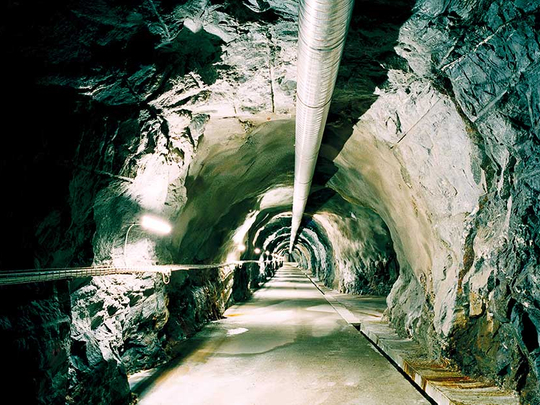
“In the summer of 1816, we visited Switzerland, and became neighbours of Lord Byron,” Mary Shelley wrote in her introduction to the 1831 edition of Frankenstein. “At first we spent our pleasant hours on the lake, or wandering on its shores ... But it proved a wet, ungenial summer, and incessant rain often confined us for days to the house.”
The gloomy, claustrophobic environment of Byron’s rented Villa Diodati near Lake Geneva provided the immediate context for her remarkable novel, written when she was 18, in response to Byron’s challenge to his house guests that they each write a ghost story. After days of trying to think of a starting point, the “creature” that has stalked the imagination of readers ever since came to her in a dream that, as she later put it, unfolded “with a vividness far beyond the usual bounds of reverie”.
However, it was the stark elemental beauty of the surrounding Alpine landscape that provided the backdrop for one of the novel’s most dramatic descriptive passages. Narrated by the troubled scientist Victor Frankenstein, as he walks alone in the mountains, it evokes both the brooding power of nature and his anxious state of mind:
The abrupt sides of vast mountains were before me; the icy wall of the glacier overhung me; a few shattered pines were scattered around; and the solemn silence of this glorious presence-chamber of imperial Nature was broken only by the brawling waves, or the fall of some vast fragment, the thunder sound of the avalanche, or the cracking reverberated along the mountains of the accumulated ice, which, through the silent working of immutable laws, was ever and anon rent and torn, as if it had been but a plaything in their hands.
Before starting an artist’s residency in Bagnes, Switzerland in 2016, British photographer Chloe Dewe Mathews began researching the history and geography of the area. “I knew that Shelley had visited the Mer de Glace in the French Alps,” she says, “and that the mountains around Villa Diodati were a crucial element of the psychological, as well as physical, landscape of her novels. So that was my tentative conceptual starting point on my journey to produce a contemporary creative response to the book.”
In her initial research, she read about the cause of the “wet, ungenial weather” that kept Shelley and her company confined in their villa for days on end. The previous year, Mount Tambora in Indonesia had erupted, producing an ash cloud so vast and thick that it blocked out sunlight across the globe, causing temperatures to plummet and crops to fail. Throughout Europe, 1916 became known as “the year without a summer”. The incessant rainfall that Shelley refers to in her introduction also caused a vast lake to form behind the Gietro glacier in the upper Bagnes valley. In 1818, the year in which Frankenstein was published, the glacier cracked and a torrent of water coursed through the valley below, causing death and destruction in the villages of Bagnes and Martigny-Bourg. The so called “debacle du Gietroz” remains imprinted on the collective memory of the people who live in the region.
All of these events and portents, creative and cataclysmic, underpin Dewe Mathews’s exhibition, In Search of Frankenstein — Mary Shelley’s Nightmare, which opened at the British Library recently. “After making the connection between Geneva, the Swiss Alps and the epiphany that inspired Shelley to create her iconic work,” she writes in her introduction to the accompanying book, “I packed my old copy of Frankenstein and took it with me on my first trip to Switzerland. I carried it up to the glacier and read it on the snowy mountainside.”
There, she found that the glacial landscape described in the novel had been replaced by a fragile natural environment increasingly under threat from rising temperatures and mass tourism. “We assume that mountains are unchanging,” she says, “but there is now a motorway through the region that looks from above like a smear of grey and, year by year, [signs that] the ice level is receding.”
In her photographs, the Alpine landscapes around the Corbassiere glacier, the Gietroz glacier and the Mauvoisin Dam are rendered almost ghostly, with tall, snow-dusted trees standing on steep slopes that give way to an indeterminate zone that could be sky or incoming snow. Early on, she made a creative decision to overexpose the film slightly, which lends an even more ethereal and slightly ominous atmosphere to her images. In one, three stone figures stand forlorn on pillars, their silhouettes the same grey-blue tone as the rocky surfaces that no longer lie shrouded in a deep layer of snow. In another, the still surface of an ice-blue lake has an almost hyperreal sheen that speaks of the sublime. Elsewhere, her eye has picked out the traces of tourism: an advertising hoarding affixed to a rocky promontory, snaking tyre tracks on slushy roads.
As well as trekking over the mountains, Dewe Mathews journeyed into them, exploring the vast warren of nuclear shelters that were built by the state in the 1960s. “There are bunkers all over Switzerland, many under private houses, but also concentrated in this elemental mountain landscape,” she explains. “Bizarrely, there is enough capacity in this one region to house the entire population of the country in the event of a nuclear attack or accident.”
In stark contrast to the mysterious exterior landscapes, her images of the bunkers evoke a world of almost absurdist functionality, a subterranean web of kitchens, canteens, washrooms, classrooms, meeting rooms and, of course, store rooms. All are harmonised by muted colour schemes — sky blues, pale greens and soft pinks — which add to the strangely suspended atmosphere of a place that, as long as it remains empty of hordes of frightened people, retains an air of quasi-normality.
“Usually a caretaker would let me in, and I would wander alone for a few hours down there in this airless place that smelt vaguely of disinfectant,” she recalls. “The atmosphere was eerie at first because of the emptiness, but there is a certain practical beauty to the design that is very Swiss. Some of the bigger shelters are actually used to house children on school trips to the mountains.”
If the towering snow-covered Alps are, as Shelley instinctively recognised, a profoundly symbolic landscape that reflects both our hubris and our helplessness in the face of nature, these manmade subterranean structures speak of more contemporary fears and anxieties. Some of Dewe Mathews’s most ominous images are of the manmade tunnels that run deep into the core of the mountains linking the bunkers. Miles of electric cable snake along the sides and long metal ventilation tubes hang overhead. It is an enclosed world entirely at odds with the expanse of mountains and valleys above. Here, as in Frankenstein, the idea of scientific progress is imbued with a darker, dystopian aspect.
“I am exploring ways in which to project the past on to the present,” says Dewe Mathews, whose previous work includes the series Shot at Dawn, about the First World War sites where army deserters were executed. “In the Alps, it was all about making a journey with her text in mind and realising that what you read infuses, not just what you look at, but how you look.”
Frankenstein has lent itself to many readings since it was first published, without Shelley’s name on the cover. Two hundred years on, Dewe Mathews’s project demonstrates that it is still being reinterpreted in ways the 18-year-old author could never have imagined — even in her wildest dreams.
–Guardian News & Media Ltd
In Search of Frankenstein is at the British Library, London, until July 1.













